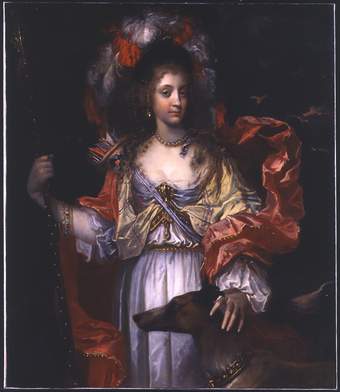
Fig.1
Jacob Huysmans
Portrait of a Lady, as Diana ?c.1674
Tate
T00901
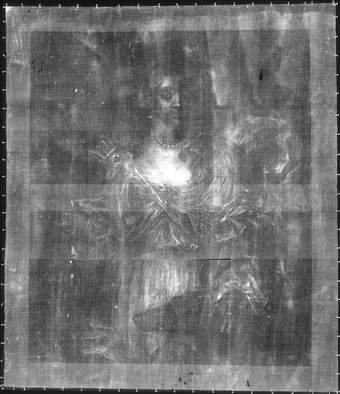
Fig.2
X-radiograph of Portrait of a Lady, as Diana ?c.1674
This painting is in oil paint on canvas measuring 1197 x 1013 mm (fig.1). The support is composed of a single piece of plain woven linen with 14 vertical and 16 horizontal threads per square centimetre (fig.2). The painting has a glue paste lining; lining and stretcher appear to date from the nineteenth century. The tacking edges were removed at some time in the past and some of the composition was thought to have been lost from the top edge, although this seems unlikely given the presence of cusping there.1 When acquired by Tate, the painting had a painted wooden batten, clearly not original, attached to the top edge but this was removed in 1983 when the painting was cleaned.
Old bar marks from an earlier stretcher or strainer are visible at the left and right edges, about 50mm into the picture plane. The bar mark at the top edge is about 45mm into the picture plane and there are faint remains of a bar mark at this same distance from the bottom edge; it is possible, therefore, that some 5mm’s worth of the composition has been trimmed at these two edges. Cusping is visible at the top and left edges but not along the bottom and right, perhaps suggesting a slight reduction of the composition but more likely that the cusping relates to the priming stage.

Fig.3
Cross-section taken from a damage in the red sky, 23 mm from the right edge and 340 mm from the top, photographed at x380 magnification. From the bottom of the sample upwards: grey ground; brown sky paint; dark red glaze. Note the presence of lead soap aggregates in the ground at the left, with associated red lead
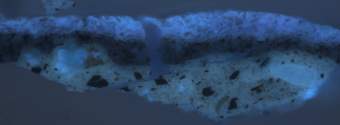
Fig.4
The same cross-section as in Figure 3, photographed at x380 magnification in ultraviolet light. Note the fluorescence of the top layer, which indicates a resinous binding medium
The ground layer is warm grey in colour. It contains the following pigments mixed together and bound in oil: shows lead white, cologne earth, black, burnt sienna, umber, some glassy particles and a trace of pipeclay and gypsum.2 Lead soap aggregates have developed throughout the ground layer, as seen in figs.3−4.3
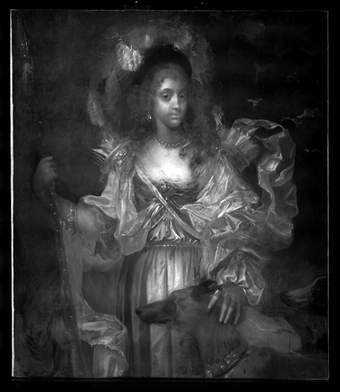
Fig.5
Infrared reflectogram of Portrait of a Lady, as Diana ?c.1674
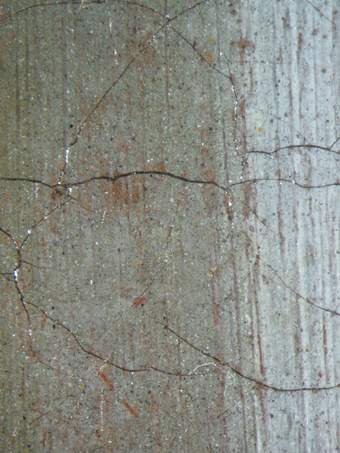
Fig.6
Photomicrograph at x8 magnification of red underpainting beneath the white dress
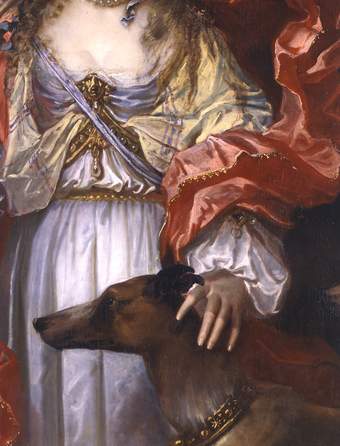
Fig.7
Detail of the figure in Portrait of a Lady, as Diana ?c.1674
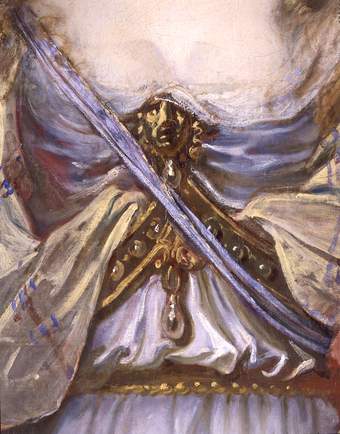
Fig.8
Detail of the costume in Portrait of a Lady, as Diana ?c.1674
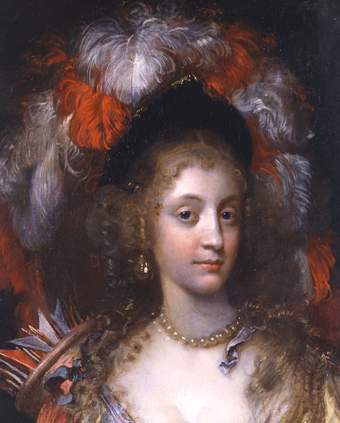
Fig.9
Detail of the head in Portrait of a Lady, as Diana ?c.1674
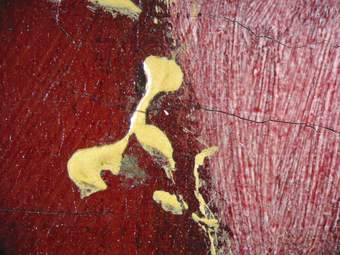
Fig.10
Photomicrograph at x8 magnification of highlights and mid-tones with unifying red glaze and yellow impasto
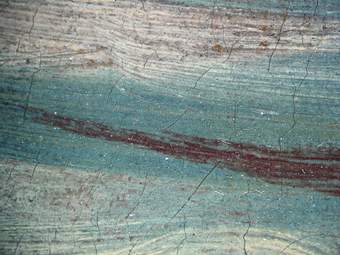
Fig.11
Photomicrograph at x8 magnification of blue used in the folds of the yellow shawl, with red lake used for the shadow

Fig.12
Photomicrograph at x8 magnification of slightly faded red lake glaze used to heighten the modelling of the shawl
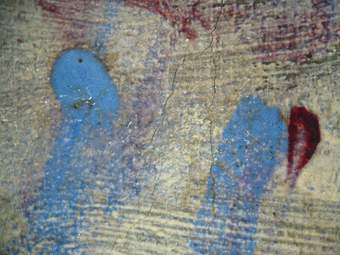
Fig.13
Photomicrograph at x8 magnification of ultramarine and red lake decoration in the shawl

Fig.14
Photomicrograph at x8 magnification of the blue sash with ultramarine glaze

Fig.15
Photomicrograph at x8 magnification of brushwork in sitter's jewelled bodice
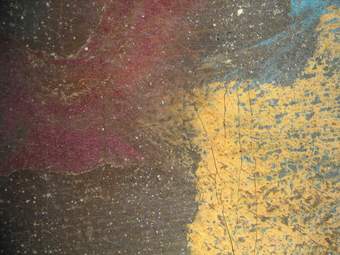
Fig.16
Photomicrograph at x8 magnification of colourful brushwork in the sky
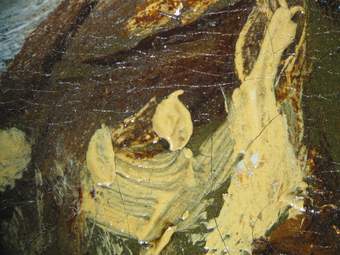
Fig.17
Photomicrograph at x8 magnification of brushwork in the necklace
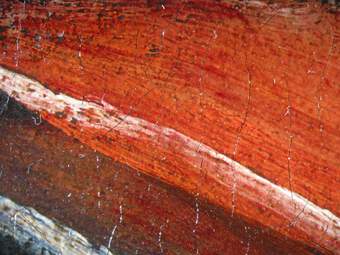
Fig.18
Photomicrograph at x8 magnification of red lake glaze on arrow tip
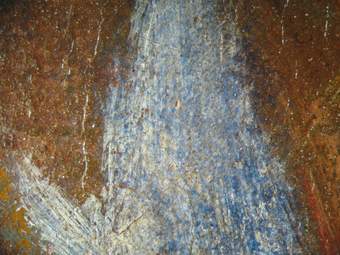
Fig.19
Photomicrograph at x8 magnification of blue glaze on arrow tip
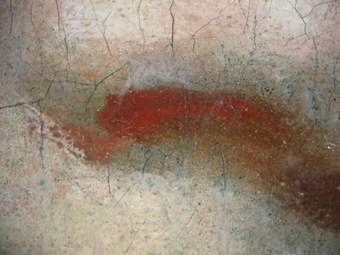
Fig.20
Photomicrograph at x8 magnification of the nostril with loose brushwork over grey ground
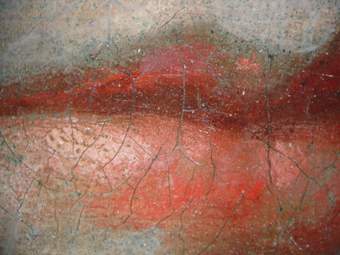
Fig.21
Photomicrograph at x8 magnification of the lips, showing grey ground left visible to define the feature
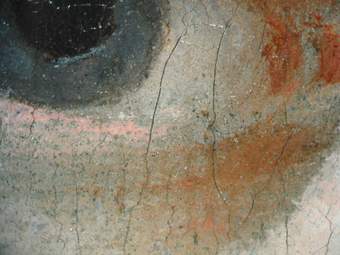
Fig.22
Photomicrograph at x8 magnification of the sitter's right eye, showing grey ground left visible

Fig.23
Photomicrograph at x8 magnification of the sitter's left eye
No underdrawing was detected with infrared reflectography (fig.5). There is extensive, modelled, red underpainting beneath the white dress (fig.6) but otherwise the composition seems to be laid down directly on top of the grey ground using a wet-in-wet technique. The brushwork is quick, expressive and sure handed, with glazes and fine detail added on top when the main painting was dry (figs.7–19). The colour of the ground has been exploited by the artist and is left visible in the shadowed areas of the flesh tones (figs.20–23).
Some technical investigation was undertaken at the National Gallery, London, by the late Joyce Plesters in 1978. Chemical analysis was undertaken and cross-sections prepared, resulting in the identification of lead-tin yellow and indigo. Plesters described the build-up of the flesh paint as several thin layers of similar composition (lead white, red and brown earth colour sometimes with a small addition of blue). The red cloak is painted with a bodycolour of vermilion followed by a crimson-coloured lake glaze. Ultramarine was identified in the bright blue strips of the scarf but indigo was also found in the blue-green shadows. The blue strips go over a yellow paint, which was found to be a mixture of lead white and lead-tin yellow. This contrasted with the yellow of the dog’s collar, which was found to be a yellow earth pigment. Recent technical analysis at Tate confirmed these findings, with the addition of chalk, Cologne earth, pipeclay and glassy particles in many of the mixtures. The pigment size is relatively coarse, particularly the intense black which is readily seen at the surface, under low magnification, as discrete particles in many colour mixtures. This black could not be identified precisely in analysis, except that it is not bone black.
The artist made several alterations to the composition during the course of painting. Not all are visible in the infrared reflectograph. A change in the position of the quiver and the string of pearls produced an alteration of the angle of the sitter’s right shoulder. It would appear that the sitter’s sleeve and right hand and forearm were re-positioned at a late stage in the execution of the painting. The left hand and cuff on the right can be seen to go over the already glazed red cloak and brown background, with no sense of the reserves seen elsewhere for the head or for the dog. Because these last changes are visible only with surface examination, we cannot see how the arm looked at an earlier stage.
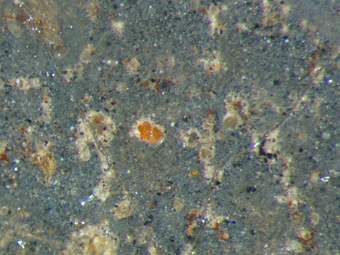
Fig.24
Photomicrograph at 32 magnification of lead soap aggregates protruding through sky paint
With time some change has occurred to the appearance of the sky, which contains deep reds, bright oranges and blues and would probably have looked vibrant and dynamic. The sky now has a darkened appearance, partly due to wear and disruption by the formation of lead soap aggregates in the paint, which have pushed through its surface and then been damaged by early cleaning treatments. Some of these aggregates have been developing for a long time, and have reached the late stage where opaque, orange coloured red lead is formed, as well as white compounds that are more transparent than the lead white pigment they have replaced (fig.24). This increases the optical dominance of the dark grey ground. The residues of old varnish, not removed during earlier cleaning treatments, are present.
March 2020
